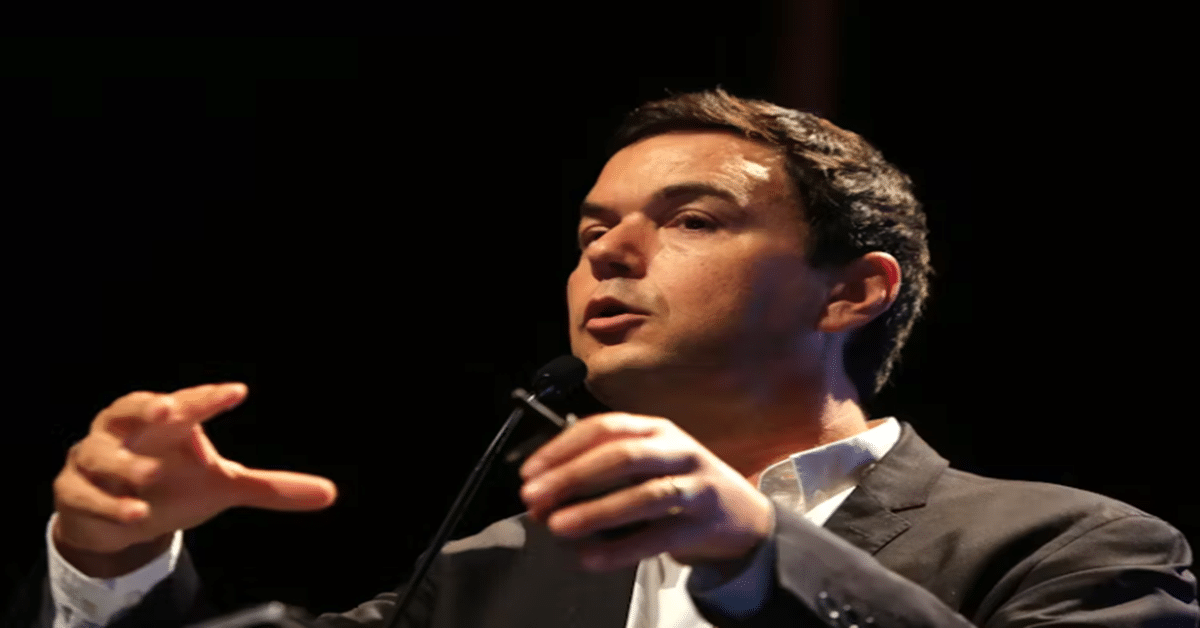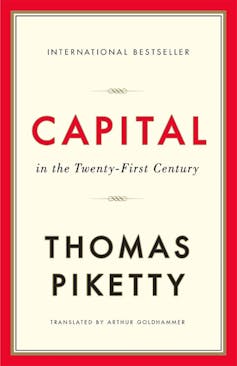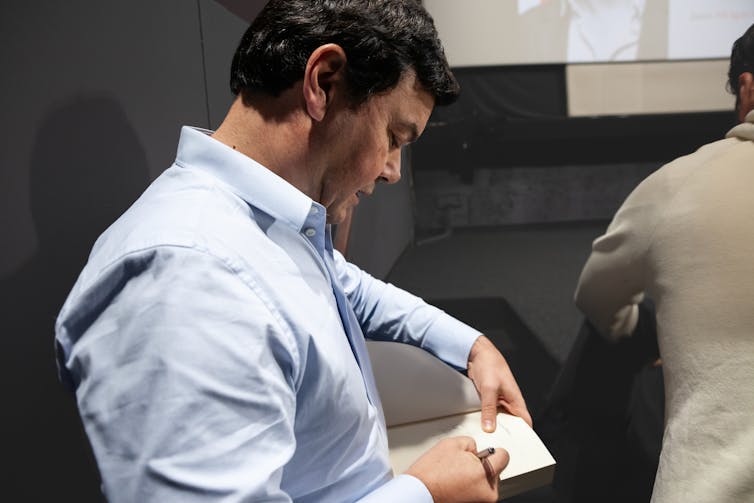Is Inequality Natural? Thomas Piketty Says No and Proposes a Solution

Thomas Piketty’s Nature, Culture, and Inequality is a little book that addresses an issue of great significance: is the social inequality we observe every day natural?
Drawing on historical economic data from around the world, Piketty describes a tendency since the late 18th century toward greater political and socioeconomic equality. This was particularly apparent in Western countries from around 1914 to around 1980. There has since been a pronounced slowing of that trend.

Piketty points out that inequality manifests in different ways in different societies; it also manifests in different ways in the same societies over history. Inequality, he says, has “followed markedly different trajectories – political, socioeconomic, cultural, civilizational, and religious”.
This shows us that human culture is more variable, and therefore more malleable, than many have assumed. “It is culture in the broadest sense,” he argues, “and more particularly political mobilization” that “provides an explanation for the diversity, degree, and structure of the social inequalities we observe.”
As such, there is no reason why we cannot continue the 20th century arc of development towards greater equality in the present century. In fact, without seriously addressing inequality, Piketty argues, we cannot hope to adequately address the climate crisis.
Review: Nature, Culture, and Inequality – Thomas Piketty, translated by Willard Wood (Scribe)
Piketty is a professor at the École des Hautes Études en Sciences Sociales (EHESS) and the Paris School of Economics, and co-director of the World Inequality Lab. He is best known for his landmark Capital in the Twenty-First Century (2013), which became a bestseller and sparked a global debate about capitalism, inequality and taxation policy.
Using historical analysis and statistics, Piketty argued that if the return on capital exceeds the growth rate of the economy, it follows that wealth will become increasingly concentrated. This, in turn, leads to alarming increases in inequality, which are not only unfair but undermine democratic and meritocratic values, trust in institutions and social cohesion.

Piketty’s new book is designed to make his thought available to a wider audience. It is adapted from a 2022 lecture drawing on historical and comparative research on inequality from the World Inequality Database and his book A Brief History of Equality (2021).
Conversational in style, and accompanied by attractive colour charts, the book moves briskly through topics including income and wealth inequality, gender inequality, the rise of the welfare state, education spending, progressive taxation of income and inheritance, the collapse of colonial assets, public debt crises, and the climate crisis.
Piketty distils some of his key insights about the development of income and wealth inequality across history, and presents what he views as the key to a more just and sustainable world.
Income and wealth inequality
When it comes to income (who earns what), the bottom 50% of earners receive 5-6% percent of total income in the most inegalitarian countries (e.g. South Africa). In more egalitarian countries (e.g. those in northern Europe), the bottom 50% earn 20-25% of total income.
The distribution of wealth (who owns what) is even less equal. The poorest 50% do not own more than 5% of total wealth in any country on earth.
As important as they have been, advances towards reducing inequality in the 20th century mainly concerned the distribution of income. “When it comes to the distribution of wealth,” Piketty argues, “things have changed very little.”
As he points out, the “great redistribution” of property in his native France, largely between 1914 and 1980, had “a significant impact on reducing disparity between the richest 10% and the next 40%”, via the emergence of a “property-owning middle class”. Despite this important development, “the poorest 50% have hardly benefited from the redistribution of property in the past two centuries at all”.
Piketty argues that, like the 20th century movement towards greater equality, recent patterns of increasing inequality are not inevitable. Nor are they explainable in terms of “personal talent, native endowment or natural temperament”.
As journalist Jonathan Portes summarises, the idea that “great disparities are somehow ‘natural’, because ability or entrepreneurialism is unevenly distributed across individuals (or countries, or ethnic groups)” is regularly “used to argue that efforts to reduce inequality will either be ineffective or reduce growth and prosperity, or both.”
This claim is not supported by the historical data, says Piketty. He rejects the view, which dominates much contemporary economic thinking and policy discussion, that “very large inequalities are the inevitable outcome of a well-functioning market economy”. The key to understanding reductions in inequality, he argues, is that they are directly related to a country’s political culture and institutions. In particular, they are a result of the historical role of collective political mobilisation to drive policy change.

BalkansCat/Shutterstock
What works: Sweden vs. the United States
Sweden in the 20th century, Piketty writes, is an example of the power of political organisation, social struggle and “the ability to build new institutional outcomes”.
Until around 1920, Sweden, like other European countries, was “extremely inegalitarian”. It had an elitist political system. Only the richest 20% of men could vote. Votes were apportioned based on individual wealth: the richer you were, the more votes you could cast.
Then a “collective mobilization” by the trade unions and the Social Democratic Party “put the state capacity of Sweden to the service of a […] different political project”. Rather than use “the records that had made it possible to measure income and property” to allocate the right to vote, they used them to “impose a progressive tax, with the goal of funding access to education and healthcare”.
Piketty argues that the Swedish example is instructive on several fronts. Firstly, it shows that “a country is never inegalitarian or egalitarian by nature”: it “depends who controls the government and to what end”. Secondly, Sweden’s social democratic policies led to it becoming both one of the most equal societies in the world, as well as one of the richest.
The United States makes an interesting comparison. In recent history, the wealth of its middle class has been shrinking. Having at one point reached similar wealth distribution to Europe, it is now headed in the direction of “Europe’s pre-World War I levels”.
Inequality decreased in the United States between 1932 and 1980. During that period, the country had progressive income and inheritance tax rates, and a prosperous economy that “stifled neither economic growth nor innovation”. The totemic Reagan-era slashing of top tax rates in the 1980s did not achieve what its supporters promised. Economic growth in the United States in the period 1990-2020 was half what it was in 1950-1990. Inequality accelerated.
Addressing inequality
Imperfect though the process has been, the development of the welfare state was the most important factor in addressing inequality in the 20th century. Progressive taxation was used to fund increased spending in healthcare, pensions, housing, infrastructure and education. Piketty argues that the roughly tenfold increase in public spending over the century was an important factor in promoting individual freedom, reducing inequality, and raising productivity and living standards.

The question of what might represent “acceptable levels” of income disparity, according to Piketty, is “clearly a question that a democratic process and public deliberation should deicide”. But he proposes a ratio between the poorest and richest somewhere in the order of 1 to 3 or 1 to 10. These levels can accommodate diversity of aspirations, while maintaining the incentives “necessary for social and economic organization”. Nothing, economically or socially, justifies ratios of 1 to 50 or 1 to 100.
A crucial factor in the United States’ historical advantage over its competitors in productivity, especially in the industrial sector, was not low tax rates or astronomical corporate incomes. It was its lead in education. The “near-universal” access to secondary education the United States achieved in the 1950s was not realised in Germany, France and Japan until the 1980s and 1990s.
Since then, despite the significant expansion of access to tertiary education, with its acknowledged advantages, spending on education across Western countries has stagnated.
Inequality and the climate crisis
Returning to the theme of “nature” at the end of his book, Piketty argues that understanding inequality helps us to better understand the issue of climate change, and thus what we need to do to address it. In an interview with New York Times reporter Manuela Andreoni, he succinctly states his main point:
There’s no way we can preserve […] planetary habitability in the long run if we don’t address our inequality challenge at the same time.
This is partly because of the comparatively high carbon emissions from the Global North compared to the Global South. But it is also because of carbon emission inequalities within countries – in particular, the large carbon footprints of the wealthiest 10%.
“It is clear that we’re going to have to change our production and consumption regime throughout the world,” Piketty observes. This will need to be society wide, but with particular focus on the rich and the middle class:
There’s simply no way that the middle class and lower income groups are going to accept the kind of transformation that is needed if you don’t ask for a much bigger effort from the people at the top.
Piketty thinks that the climate crisis “may lead to a greater demand for equality than we’ve recently seen”. In the 20th century, many countries achieved the expansion of access to health care and education – and, “to a lesser extent, transport, housing and energy” – by taking these parts of the economy out of market frameworks and viewing them as a public good.
“A similar shift,” he suggests, “could help the world curb climate change and stop biodiversity loss.” When Andreoni asks about sceptical and cynical responses to such a proposal, Piketty replies:
that’s what we did for education and health. We just decided that it was important for all children at age 6 and then at age 10, and then at age 15 and then at age 18 to learn about this, and that. And we didn’t let the market system decide this. And now nobody wants to go back to the previous situation.
Christopher Pollard, Sessional Academic in Sociology and Philosophy, Deakin University
This article is republished from The Conversation under a Creative Commons license. Read the original article.
Observer Voice is the one stop site for National, International news, Sports, Editor’s Choice, Art/culture contents, Quotes and much more. We also cover historical contents. Historical contents includes World History, Indian History, and what happened today. The website also covers Entertainment across the India and World.

